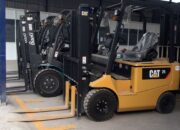Solutions for Selecting Forklifts for Cold Storage
Cold storage plays a crucial role in the supply chain of numerous industries, ranging from food and pharmaceuticals to chemicals. Managing and operating cold storage facilities requires specialized equipment, particularly forklifts, to ensure efficiency and safety. In this article, we will introduce forklift solutions for cold storage, helping businesses optimize their workflow and protect goods in low-temperature environments.
Characteristics of Cold Storage Forklifts
Forklifts designed specifically for cold storage have unique technical features to meet the stringent requirements of this environment.
Cold Resistance
- Frost-resistant materials: Cold storage forklifts are made from materials that can withstand low temperatures, preventing freezing or damage due to cold.
- Electrical systems and batteries: The batteries and electrical systems of these forklifts are designed to operate stably in temperatures as low as -30°C, ensuring that the forklift’s performance is not reduced.
Working Performance
- Powerful engines: Cold storage forklifts are often equipped with high-powered engines to maintain performance in cold environments, where ordinary equipment may be affected.
- Lifting and lowering speeds: Forklifts in cold storage need fast lifting and lowering speeds to minimize exposure to cold air, protecting both goods and operators.
Safety and Security
- Braking systems: Cold storage forklifts are equipped with special braking systems to ensure safety when moving on slippery, frozen floors.
- Cabin design: The forklift cabin is typically insulated and has a heating system to protect operators from low temperatures.
Benefits of Using Forklifts in Cold Storage
Using specialized cold storage forklifts provides significant benefits for businesses.
Increased Work Efficiency
- Workflow optimization: Forklifts help move goods quickly and accurately, reducing time and effort compared to manual labor.
- Reduced risk of damage: Forklifts designed to operate in cold environments help protect goods from damage due to unsuitable temperature exposure.
Reduced Labor Costs
- Labor savings: Using forklifts reduces the need for manual labor, thereby reducing labor costs and increasing cost-effectiveness.
- Increased productivity: Forklifts allow for the transport of more goods in a single move, improving work productivity.
Improved Safety
- Reduced workplace accidents: Forklifts are equipped with safety features such as braking systems and warning lights, helping to minimize accidents during operation.
- Operator protection: Insulated cabins and heating systems protect operators from the adverse effects of low temperatures.
How to Choose the Right Forklift for Cold Storage
Choosing the right forklift for cold storage is crucial for ensuring efficiency and safety. Consider the following factors:
Storage Size and Type
- Storage area: For small cold storage areas, pallet trucks or stand-on electric forklifts may be suitable. For large storage areas, diesel or gas forklifts may be necessary.
- Lifting height: Determine the maximum height the forklift needs to reach to load and unload goods on high shelves.
Type of Goods
- Cargo weight: Choose a forklift with a load capacity suitable for the weight of the goods in the storage. For heavy goods, a forklift with a large load capacity is necessary.
- Cargo dimensions: The forklift should have fork dimensions suitable for the pallets or containers holding the goods.
Budget
- Investment cost: Electric forklifts typically have a higher initial investment cost but lower operating costs compared to diesel or gas forklifts.
- Maintenance costs: Cold storage forklifts require regular maintenance to ensure stable operation, so maintenance costs should be considered within the budget.
Notes When Using Forklifts in Cold Storage
To ensure safety and efficiency when using forklifts in cold storage, businesses must adhere to the following notes:
Regular Maintenance
- Check batteries and electrical systems: Batteries and electrical systems should be checked regularly to ensure stable operation in cold environments.
- Lubricate parts: Moving parts should be lubricated with cold-resistant grease to prevent stiffness or jamming.
Employee Training
- Operating instructions: Employees should be trained on how to operate forklifts in cold storage environments, including driving and safety skills.
- Safety regulations: Ensure employees comply with safety regulations such as wearing protective clothing and using personal protective equipment.
Comply with Safety Regulations
- Regular inspections: Forklifts should be inspected regularly to ensure compliance with safety standards and legal regulations.
- Insurance: Businesses should consider purchasing insurance for forklifts and employees to prevent unexpected risks.







